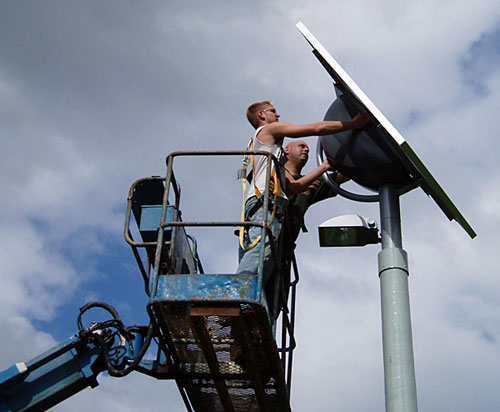Solar Lighting: Making Steps Off-Grid towards a Sustainable Future
Light Emitting Diodes (LED) as a technology is not new, but the use of LEDs in commercial and residential lighting is. Similar to the introduction and commercialization of compact fluorescent lamps, there is a learning curve taking place for consumers, specifiers and manufacturers. Testing procedures and standards for LED lighting are still being created and adjusted as research continues and performance improves. Being an electronics-based technology much of the lighting world has had to retrain staff and gather new skill sets to become experts in the field. Such excitement about the technology has influenced many to make the leap to LED lighting without doing their homework. There is a wide variety of quality in LED lamps and luminaires available today. Due to varying quality, exaggerated claims and the fear that public acceptance may be harmed has spurred the U.S. Department of Energy (DOE) and the Next Generation Lighting Industry Alliance (NGLIA) to create the Lighting Facts Program. Lighting Facts is a voluntary pledge program to assure that LED lighting products are represented accurately in the market. The program requires submission of independent testing results from certified labs; upon approval the certified specifications are compiled into a label that can be used for marketing purposes. Having the label will not only provide vital performance information but will also allow the consumer to be confident that they are getting the performance claimed. Comparing solar lighting systems involves understanding performance and distribution of the luminaire, quality of components, as well as achievable runtimes and light levels. As with many technical products it is wise to consult with manufacturers to get answers to these questions in order to make the most appropriate selection for a project and ensure successful implementation of the technology.
 |
Installers complete an installation at Fairmont Park, PA. Photo: SELUX Corp. |
Â
Comparing LED and traditional luminaires. An LED is an electronic semiconductor device and differs greatly from traditional light sources. Therefore new methods of testing and comparing LED sources and luminaires are necessary. Performance of a single LED or an array of LEDs packaged as a "light engine" is greatly affected by heat. For this reason, performance of an LED light engine will change a great deal when incorporated into a luminaire or form. The ability of the luminaire to remove heat from the LEDs through conduction/convection is critical. High temperatures inside the fixture can significantly reduce the light output and life of the LEDs. Absolute photometry is a testing procedure recently established by the IESNA to provide a more appropriate way to measure LED lighting distribution and output. The absolute photometry method measures overall lumens delivered and power consumed by the LED luminaire under given standard testing conditions. This method does not consider the specified lumens or watts of each individual LED since these values change with environment. Instead the luminaire is evaluated as a complete package. Testing of traditional luminaires has been done following the relative photometry method. With relative photometry the lamp in a given position can be accurately measured outside of the fixture. Since the lamp performance will not vary much when installed, the fixture and lamp can now be tested together to determine how many lumens the optical system emitted from the housing relative to the total lamp lumens. This is referred to as the luminaire efficiency. When you compare LED and traditional luminaires, be sure you are comparing apples to apples or in this case, delivered lumens to delivered lumens. Specifications of the individual LEDs are more relevant to an engineer designing the luminaire than a specifier or customer reviewing the final product.









